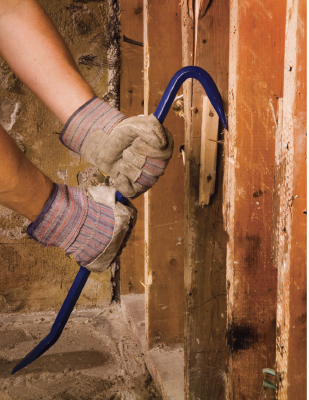Hand tools are crucial to the success of any project—and with a wide selection of hand tools available, finding the best tool for the job can be a simple process. However, neglecting to maintain your tools, or misusing them, poses serious health and safety problems.
Unfortunately, for people who use their tools day in and day out, it becomes all too easy to work on auto-pilot mode, ignoring basic safety practices and becoming casual with the way these tools are handled. Proper tool inspection, use, and maintenance will help ensure your safety and assist you in completing the job on schedule. Therefore, we’ve outlined some hand tool safety tips for you to keep in mind before, during, and after your project.
BEFORE THE PROJECT
There are some important steps to take before beginning every project. Selecting the best tool, performing an inspection and preparing your workspace will help you to work safely and efficiently.
First, consider the shape, size, and handle of the tool. You should only use tools that are properly sized for the job and workspace. Close quarters with several workers require not only smaller hand tools, but also ones with better safety features.
Next, inspect the tool for any defects. This might include an ill-fitted handle, a chipped hammer head, a worn screwdriver tip, mushroomed chisels, and more. If a damaged tool cannot be fixed by a professional, it will need to be replaced to prevent future injury. A damaged tool might cause broken pieces of the tool to chip, fly off the handle or shatter, among other concerns—potentially causing injury to you and any other people present.
Additionally, ensure the tool is comfortable to hold and operate. A tool should maintain wrist stability and not require you to engage in any straining postures. Your tool should require minimal force to complete a task and should be easy to grip and use.
Lastly, before beginning a project, ensure you are equipped with the required tools and that your workspace is clean and cleared of debris. Following these simple practices will help prevent damage to the tool and mitigate the risk of injury.

DURING THE PROJECT
Once you are ready to begin the project, there are some other important safety tips to keep in mind.
Only use hand tools for what they were designed to do. While many people on the job will use a wrench as a hammer or a screwdriver as a pry bar when they’re in a pinch, this will ultimately put you, your project, and your team at risk.
Ensure you are wearing all required protective equipment such as gloves, boots, hats, and goggles. Not doing this could put you at risk for injury, and you could also face a hefty fine if the site’s safety supervisor sees you without these items. Furthermore, all equipment should be well-fitted. Using a hand tool with an oversized glove, for example, could put one at risk for injury.
If moving hand tools to and from a worksite, ensure you have invested in a high-quality, durable toolbox. While on the job, store hand tools in a secure, well-kept belt. The tool belt is one of those items that can diminish in quality over time without realizing it. A small hole or a few loose stitches can quickly result in the inability to properly hold tools. If carrying any sharp tools, ensure they are stored in a sheath or holster and not on your workbench to be dropped or otherwise misused.
Additionally, while working on a ladder or at height, hand tools should be hoisted up and down using a bucket or bag. This prevents tools from slipping or falling and also ensures you are able to work without the weight of a belt.
AFTER THE PROJECT
Upon completing your project, there are still some important safety procedures to follow.
First, ensure you are properly maintaining and storing hand tools to prevent further damage. Tools should be cleaned regularly and kept in a clean, dry place.
Cover any sharp edges and point sharp hand tools away from the aisles. Ensure no tools hang over the edge of storage or work benches. Also make sure any storage cabinets or boxes with wheels are locked and stored.
Finally, replace any tools that have been damaged. It’s important to note that even a small crack in a handle means it is due for replacement. Any tools that have been damaged should be tagged so that you or a colleague do not use them.
CLOSING THOUGHT
Taking the proper precautions before beginning a project, ensuring you adhere to safety practices while working, and properly cleaning and maintaining tools when finished will ensure you are able to complete any project efficiently and successfully. And using the above safety tips before, during, and after the job will help make sure you get the most out of your hand tools.
About the Author:
Paul Dean is the vice president of operations at Gray Tools. He has more than 30 years of manufacturing and operations experience, helping thousands of professionals build and maintain their Gray and Dynamic tool collections for years of reliable use. For more, visit graytools.com.
Modern Contractor Solutions, August 2021
Did you enjoy this article?
Subscribe to the FREE Digital Edition of Modern Contractor Solutions magazine.



